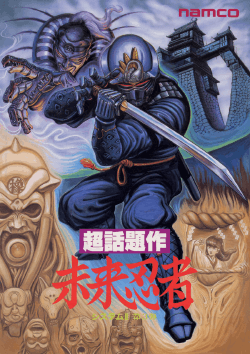Mirai Ninja (video game)
| Mirai Ninja | |
|---|---|
 Arcade flyer | |
| Developer(s) | Namco |
| Publisher(s) | Namco |
| Platform(s) | Arcade |
| Release |
|
| Genre(s) | Beat 'em up |
| Mode(s) | Up to 2 players, alternating turns |
| Cabinet | Upright, cabaret, and cocktail |
| Arcade system | Namco System 2 |
| CPU |
2x Motorola 68000 @ 12.288 MHz, 1x Motorola M6809 @ 3.072 MHz, 1x Hitachi HD63705 @ 2.048 MHz |
| Sound |
1x Yamaha YM2151 @ 3.57958 MHz, 1x C140 @ 21.39 kHz |
| Display | Horizontal orientation, Raster, 288 x 224 resolution |
Mirai Ninja (未来忍者 lit. "Future Ninja"), fully named as Mirai Ninja: Keigumo Kinin Gaiden (未来忍者:慶雲機忍外伝 lit. "Future Ninja: Stealth Joy Cloud Device Side Story"), is a side scrolling arcade game, released by Namco in 1988 exclusively in Japan. Mirai Ninja was based on the Japanese live-action film of the same name, which was also produced by Namco. The game runs on Namco System 2 hardware, and was the first game from the company to be based on a film.
Character designs and directing of the film were done by Keita Amemiya of Zeiram and Kamen Rider fame. Both the game and the movie were released in the same year. Although the arcade game was only released in Japan, the movie was released straight-to-video overseas by Orion Pictures, under the two titles of Cyber Ninja in the United States, and Warlord in Canada.
In both the film and the arcade game a man's body and soul are stolen and used as part of a demon's castle. What's left becomes a cyber-ninja named Shiranui. The player controls Mirai Ninja, who must fight various enemies and bosses by rapidly throwing shurikens at them (and slashing them with his sword at close range). His life meter uses Kanji for the numbers; this was previously done in Namco's earlier Japan-only title, Genpei Tōma Den (1986), for the score display. The penultimate stage, "Castle Kurosagi", also only has one way out of it.
Four 7"-8" tall action figures were released by Amemiya's own Crowd, Inc., in 2000. Two were Shōki figures (one was bone-colored and the other one was a red repaint). The other two were Shiranui figures (one was black, and the other one was a black and silver repaint).